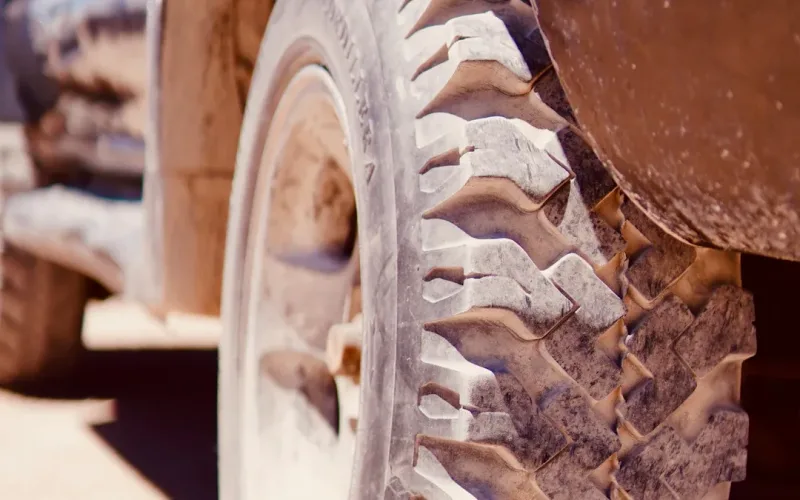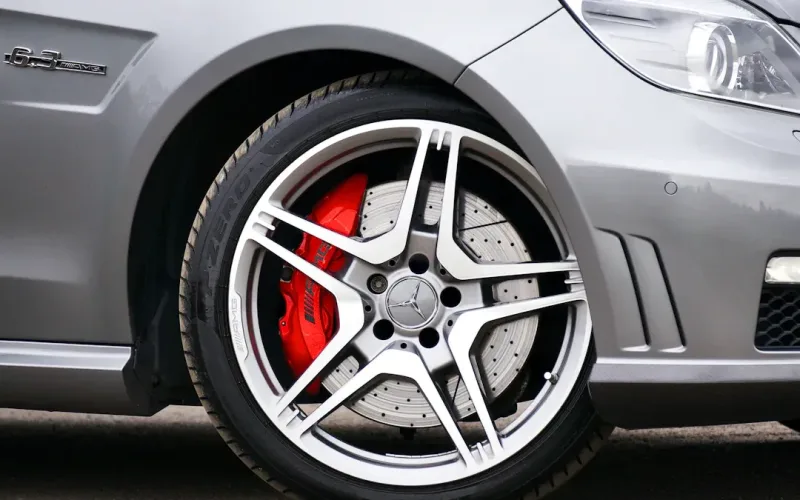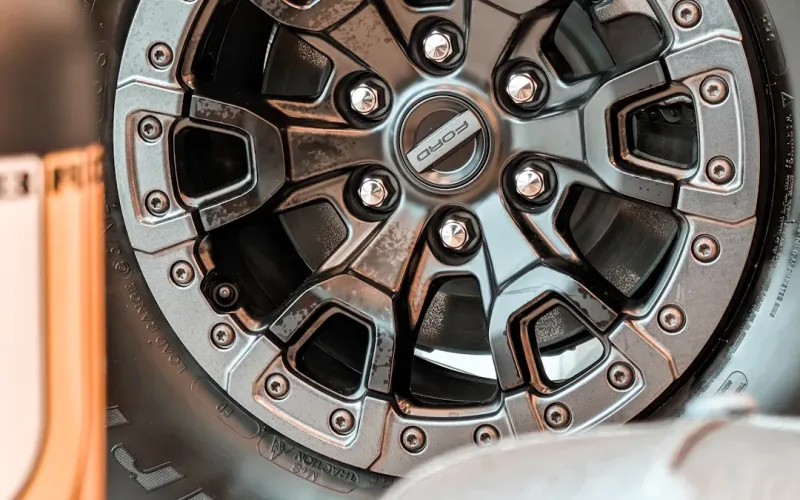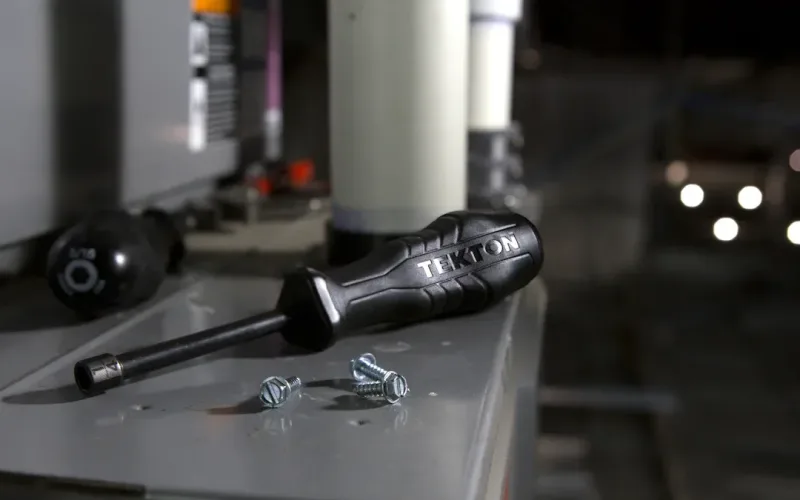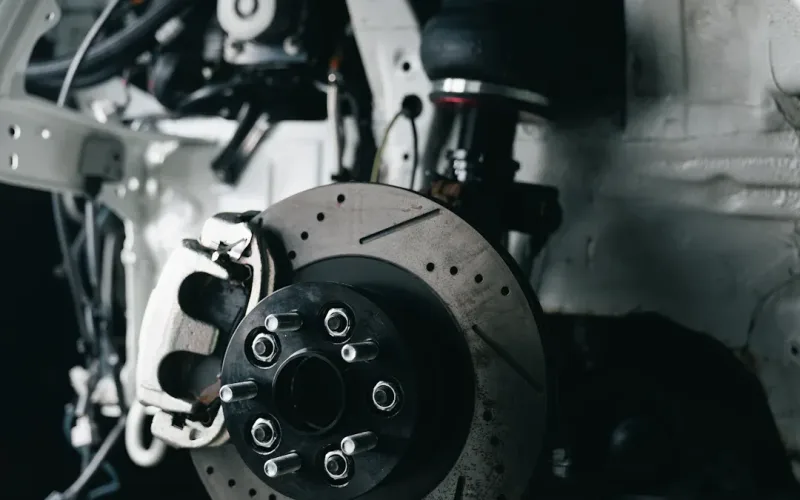

admin1
May 31, 2025
Clip-On vs Stick-On Truck Wheel Weights Pros and Cons

Choosing the right truck wheel weights can make a huge difference in how your fleet performs and how much you save on costs. Proper tire balancing doesn’t just smooth out the ride—it can boost fuel efficiency by up to 2 percent and extend tire mileage by 20 to 40 percent. Imagine saving around $5,500 per truck each year just by optimizing this one detail!
When it comes to wheel weights, you’ve got two popular options: clip-on and stick-on. Clip-on weights are known for their durability and straightforward installation, while stick-on weights offer flexibility and a cleaner look. Each type has its strengths and trade-offs, so understanding what works best for your fleet is key.
Understanding Truck Wheel Weights
Why Truck Wheel Weights Are Essential
Have you ever wondered why truck wheel weights are such a big deal? These small components play a huge role in keeping your truck running smoothly. When your tires aren’t balanced, you’ll notice vibrations, uneven tire wear, and even reduced fuel efficiency. That’s where wheel weights come in—they help distribute weight evenly across the tire and wheel assembly, ensuring a smoother ride.
The importance of wheel weights isn’t just about comfort. They’re essential for safety too. Studies show that proper tire balance weights can improve handling and braking, especially in heavy-duty trucks. For example, research on vehicle dynamics highlights how balanced wheels enhance stability during sharp turns or sudden stops. Without them, your truck could struggle to stay on course, putting you and others at risk.
The demand for truck wheel weights is also growing. According to industry reports, the global market for these weights is expected to grow from $900 million in 2023 to $1.5 billion by 2032. This growth is driven by the rise in e-commerce and global trade, which means more trucks on the road and a greater need for reliable wheel balancing weights.
How Wheel Weights Impact Performance and Safety
You might think wheel weights are just about keeping your tires balanced, but they do so much more. Balanced wheels reduce wear and tear on your tires, saving you money in the long run. They also improve fuel efficiency, which is great for your wallet and the environment.
Safety is another big reason to pay attention to wheel weights. Imagine driving a truck with unbalanced tires—it’s harder to control, especially in bad weather or on uneven roads. Studies like “Safety Implications of Various Truck Configurations” show that balanced wheels improve handling and tracking, making your truck safer to drive.
In short, truck wheel weights aren’t just an optional add-on. They’re a must-have for anyone who wants to keep their fleet running efficiently and safely.
Stick-On Truck Wheel Weights

Advantages of Stick-On Weights
Stick-on wheel weights offer a sleek and versatile solution for balancing truck tires. If you’re looking for a cleaner aesthetic, these adhesive wheel weights are a great choice. They don’t require clips or external hardware, so they blend seamlessly with your wheels. This makes them ideal for trucks with alloy or custom wheels where appearance matters.
Another big advantage is their flexibility. Stick-on weights can be applied to almost any wheel surface, giving you more options for placement. Whether your truck has unique wheel designs or tight spaces, these weights adapt easily. Plus, they’re lightweight and compact, which minimizes interference with other components.
Stick-on weights also shine when it comes to precision. You can place them exactly where they’re needed, ensuring optimal balance. This level of accuracy can improve tire performance and reduce wear over time. For fleets that prioritize efficiency, this is a major win.
Drawbacks of Stick-On Weights
While stick-on wheel weights have their perks, they’re not without challenges. The adhesive used for these weights can weaken over time, especially in extreme conditions. If your fleet operates in areas with high humidity, heavy rain, or fluctuating temperatures, the adhesive might fail. This could lead to weights falling off and unbalanced tires.
Another drawback is the installation process. Stick-on weights require a clean and dry surface for proper adhesion. If there’s dirt, grease, or moisture on the wheel, the weights won’t stick well. This means you’ll need extra prep time during installation, which can slow down maintenance routines.
Durability is another concern. Compared to clip-on weights, stick-on weights are more prone to damage from road debris or pressure washing. For trucks that face rugged terrains or frequent cleaning, this could be a problem.
Lastly, stick-on weights may not be as cost-effective for long-term use. If they fall off or get damaged, you’ll need to replace them more often. This can add up, especially for large fleets.
Clip-On Truck Wheel Weights

Benefits of Clip-On Weights
Clip-on weights are a popular choice for truck fleets, and it’s easy to see why. These weights are designed to attach securely to the wheel rim, providing a reliable and durable solution for balancing your tires. If your trucks often travel long distances or carry heavy loads, clip-on weights can handle the job without breaking a sweat.
One of the biggest advantages is their durability. Clip-on weights stay firmly in place, even when your truck faces rough roads or extreme weather. Unlike adhesive wheel weights, they don’t rely on glue, so you won’t have to worry about them falling off due to heat or moisture. This makes them a dependable option for fleets operating in challenging conditions.
Another benefit is the straightforward installation process. You can attach clip-on weights quickly using basic tools, which saves time during maintenance. For fleet managers, this means less downtime and more trucks on the road. Plus, their secure fit reduces the risk of imbalance over time, helping you maintain consistent performance.
Clip-on weights also tend to be cost-effective. Since they’re less likely to fall off or get damaged, you won’t need to replace them as often. This can lead to significant savings, especially for large fleets. If you’re looking for a balance between performance and affordability, clip-on weights are worth considering.
Limitations of Clip-On Weights
While clip-on weights have many advantages, they’re not perfect. One issue is compatibility. These weights are designed to fit specific wheel types, so they might not work with all truck wheels. If your fleet uses custom or alloy wheels, you may need to explore other options.
Another challenge is the potential impact on fuel economy and ride quality. Clip-on weights add extra weight to the wheel, which could slightly reduce fuel efficiency. Some tests have shown that significant imbalance would be needed to achieve noticeable fuel economy benefits. However, the added weight might still affect how smoothly your truck rides.
Installation can also be tricky if you’re not familiar with the process. Some users have reported unclear instructions, especially when reinstalling certain components. If the weights aren’t attached correctly, they could come loose, leading to unbalanced tires and increased wear.
Lastly, clip-on weights may not offer the cleanest look. If aesthetics are important for your fleet, you might find their visible design less appealing compared to adhesive wheel weights. This is something to keep in mind if your trucks are used for high-profile deliveries or events.
Comparing Clip-On and Stick-On Truck Wheel Weights
Durability and Longevity
When it comes to durability, clip-on weights take the lead. These weights attach securely to the wheel rim, making them highly resistant to harsh conditions. Whether your trucks are navigating muddy trails, snowy roads, or rocky terrains, clip-on weights stay firmly in place. They don’t rely on adhesives, so moisture, dirt, or extreme temperatures won’t compromise their hold. This makes them a reliable choice for fleets operating in challenging environments.
Stick-on weights, on the other hand, perform best in controlled conditions. They work well on smooth urban roads or highways where the environment is less demanding. However, their adhesive backing can weaken in wet or muddy conditions, causing them to fall off. For example:
- Stick-on weights excel on flat roads but may lose adhesion in wet or muddy environments.
- Clip-on weights outperform in obstacle-climbing tests, maintaining their grip even in soft soil or debris-filled areas.
If your fleet frequently encounters extreme conditions, clip-on weights offer better longevity. But for trucks that stick to city streets, stick-on weights can still get the job done.
Installation Process and Ease
Installing clip-on weights is straightforward and quick. You’ll need basic tools to attach them to the wheel rim, and the process doesn’t require much prep work. This simplicity can save you time during maintenance, especially if you’re managing a large fleet. Once installed, clip-on weights stay put, reducing the need for frequent adjustments.
Stick-on weights, however, demand more attention during installation. The wheel surface must be clean, dry, and free of grease for the adhesive to stick properly. This extra prep time can slow down your workflow, especially if you’re in a hurry. Plus, if the adhesive isn’t applied correctly, the weights might not stay in place for long.
If you value speed and efficiency, clip-on weights are the better option. But if you’re willing to invest a little extra time for a cleaner look, stick-on weights might be worth the effort.
Aesthetic Considerations
Let’s talk about looks. If appearance matters to you, stick-on weights have the upper hand. These adhesive wheel weights blend seamlessly with the wheel surface, giving your truck a sleek and polished look. They’re especially popular for alloy or custom wheels where visible hardware might detract from the design.
Clip-on weights, while functional, aren’t as discreet. They’re visible on the wheel rim, which might not be ideal if aesthetics are a priority. However, for fleets focused on performance over appearance, this might not be a dealbreaker.
In short, stick-on weights win in the style department, while clip-on weights prioritize function over form. Your choice will depend on whether you value aesthetics or practicality more.
Performance in Extreme Conditions
When your trucks face extreme conditions, the type of wheel weights you choose can make or break their performance. Clip-on weights are the go-to option for rugged environments. They attach firmly to the wheel rim, so they won’t budge even when you’re driving through mud, snow, or rocky terrain. Their mechanical grip ensures they stay in place, no matter how rough the road gets. This makes them a reliable choice for fleets operating in unpredictable weather or off-road conditions.
Stick-on weights, however, might struggle in these scenarios. Their adhesive backing can weaken when exposed to moisture, heat, or freezing temperatures. Imagine driving through a rainstorm or a scorching summer day—there’s a chance those weights could fall off. If your fleet operates in areas with extreme weather, you might find yourself replacing stick-on weights more often than you’d like.
Another factor to consider is road debris. Clip-on weights are less likely to get dislodged by rocks or other objects. Stick-on weights, being more exposed, can peel off or get damaged. For fleets that frequently encounter harsh conditions, clip-on weights offer better durability and peace of mind.
Tip: If your trucks operate in extreme climates or on challenging terrains, clip-on weights are the safer bet. They’re built to handle the tough stuff.
Compatibility with Wheel Types
Not all wheel weights fit every wheel type, so compatibility is a big deal. Clip-on weights are designed for specific wheel rims. They work best with steel wheels or standard rims that have a lip for the weight to clip onto. If your fleet uses these types of wheels, clip-on weights are a perfect match. They’re easy to install and stay secure.
Stick-on weights, on the other hand, are more versatile. They can be applied to almost any wheel surface, including alloy and custom wheels. If your trucks have unique or high-end wheels, stick-on weights might be your only option. Their adhesive backing allows them to conform to different shapes and designs, giving you more flexibility.
However, this versatility comes with a trade-off. Stick-on weights require a clean and smooth surface for proper adhesion. If the wheel surface is uneven or dirty, the weights might not stick well. Clip-on weights don’t have this issue, as they rely on a mechanical grip rather than adhesive.
Note: Before choosing between clip-on and stick-on weights, take a close look at your fleet’s wheel types. The right fit ensures better performance and fewer headaches down the road.
Cost-Effectiveness
Cost is always a factor when managing a fleet. Clip-on weights often come out ahead in terms of long-term savings. They’re durable and less likely to fall off, which means you won’t need to replace them as often. This can save you money on both materials and labor. For large fleets, these savings add up quickly.
Stick-on weights, while initially affordable, may cost more over time. Their adhesive can fail in harsh conditions, leading to frequent replacements. If you’re operating in a mild climate with smooth roads, this might not be a big issue. But for fleets in tougher environments, the cost of replacing stick-on weights can become a burden.
Another thing to consider is installation time. Clip-on weights are quicker to install, which reduces labor costs. Stick-on weights require more prep work, like cleaning the wheel surface, which can slow down your maintenance team. Time is money, especially when you’re managing multiple trucks.
Pro Tip: If you’re looking for a cost-effective solution that lasts, clip-on weights are a smart investment. They might cost a bit more upfront, but their durability and ease of installation make them worth it.
Choosing the Right Truck Wheel Weights for Your Fleet
Assessing Vehicle Types and Fleet Needs
Every fleet is unique, and so are its requirements. To choose the right truck wheel weights, you need to start by evaluating the types of vehicles in your fleet. Are you managing light commercial vehicles, heavy-duty trucks, or buses? Each vehicle type has different demands when it comes to wheel balancing. For instance, light commercial vehicles might prioritize fuel efficiency, while heavy-duty trucks focus on durability and load capacity.
Understanding your fleet’s key applications is also crucial. Trucks used for long-haul transportation may benefit from clip-on weights due to their durability over extended distances. On the other hand, vehicles with custom or alloy wheels, often found in urban delivery fleets, might require stick-on weights for a cleaner aesthetic and better compatibility.
Here’s a quick breakdown of application segments for wheel weights:
| Application Segment | Key Applications |
|---|---|
| Light Commercial Vehicle | Urban deliveries, short-distance hauls |
| Bus | Passenger transport, city routes |
| Truck | Long-haul freight, heavy loads |
By matching the wheel weight type to your fleet’s specific needs, you can ensure better performance and fewer maintenance issues down the road.
Considering Driving Conditions and Climate
Where your fleet operates plays a big role in deciding between clip-on and stick-on weights. Trucks that frequently encounter extreme weather or rugged terrains need wheel weights that can handle tough conditions. Clip-on weights excel in these scenarios. Their mechanical grip ensures they stay in place, even when driving through mud, snow, or rocky roads.
Stick-on weights, however, perform better in controlled environments. If your fleet operates in urban areas with smooth roads and mild weather, these adhesive weights can provide a sleek and effective solution. But keep in mind that extreme heat, cold, or moisture can weaken the adhesive, leading to potential failures.
For example, fleets operating in regions with heavy rainfall or fluctuating temperatures might find clip-on weights more reliable. On the other hand, if your trucks stick to city streets, stick-on weights can offer the flexibility and aesthetic appeal you need.
Tip: Always consider the climate and road conditions your fleet faces daily. This ensures you pick a solution that lasts longer and performs better.
Balancing Budget and Maintenance Goals
Cost is a major factor when choosing wheel weights, but it’s not just about the upfront price. You also need to think about long-term maintenance costs. Clip-on weights often provide better value over time. They’re durable and less likely to fall off, which means fewer replacements and lower labor costs. For large fleets, these savings can add up quickly.
Stick-on weights might seem more affordable initially, but their adhesive backing can fail in harsh conditions. This could lead to frequent replacements, increasing your overall expenses. If your fleet operates in mild climates, this might not be a big issue. However, for trucks in tougher environments, the cost of replacing stick-on weights can become a burden.
Here’s a look at how different technologies impact maintenance costs:
| Technology Type | Annual Maintenance Cost Range | Equipment Cost Range | Total Installed Cost Range |
|---|---|---|---|
| Bending Plate WIM | $5,000 – $5,900 | $25,000 – $32,500 | $55,000 – $65,000 |
| Single Load Cell WIM | $12,600 – $16,200 | $70,000 – $90,000 | $100,000 – $150,000 |
While this table focuses on broader maintenance technologies, it highlights the importance of balancing upfront costs with long-term savings. Investing in durable, reliable wheel weights can reduce maintenance expenses and keep your fleet running smoothly.
Pro Tip: Don’t just look at the price tag. Consider how often you’ll need to replace the weights and how much downtime that could cause. A slightly higher upfront cost might save you thousands in the long run.
Tips for Proper Installation and Maintenance
Proper installation and maintenance of truck wheel weights can save you time, money, and headaches down the road. Whether you’re using clip-on or stick-on weights, following the right steps ensures they stay secure and perform as expected. Here are some practical tips to help you get it right the first time.
1. Prepare the Wheel Surface
Before installing stick-on weights, make sure the wheel surface is clean and dry. Dirt, grease, or moisture can weaken the adhesive and cause the weights to fall off. Use alcohol or a degreaser to remove any contaminants. A clean surface ensures the adhesive sticks properly and lasts longer.
Pro Tip: Avoid installing stick-on weights in extreme temperatures. Heat can soften the adhesive, while cold can make it brittle. Aim for moderate conditions to get the best results.
2. Use the Right Tools for Clip-On Weights
Clip-on weights require specialized tools for proper installation. Using the wrong tools can damage the wheel rim or result in a loose fit. Invest in a quality wheel weight hammer or pliers designed for clip-on weights. These tools help you attach the weights securely without scratching or bending the rim.
Note: If you’re unsure about the process, consider professional installation. Experts have the experience and tools to ensure a perfect fit, reducing the risk of imbalance or damage.
3. Place Weights Accurately
Accurate placement is key to achieving proper balance. For stick-on weights, position them exactly where they’re needed based on your balancing machine’s recommendations. Misplaced weights can lead to uneven tire wear and vibrations. Clip-on weights should also be attached at the correct points on the rim to ensure even weight distribution.
4. Regularly Inspect and Maintain
Once installed, don’t forget about maintenance. Check your wheel weights regularly to ensure they’re still secure. For stick-on weights, inspect the adhesive for signs of peeling or weakening. Clip-on weights should be checked for tightness, especially after driving on rough roads.
Quick Tip: Make inspections part of your routine maintenance schedule. Catching issues early can prevent bigger problems later.
5. Avoid Overloading the Wheels
Adding too many weights can strain your wheels and reduce performance. Always follow the manufacturer’s guidelines for the maximum weight your wheels can handle. Overloading can lead to imbalance, increased wear, and even safety risks.
6. Replace Damaged Weights Promptly
If a weight falls off or gets damaged, replace it as soon as possible. Driving with unbalanced wheels can cause vibrations, uneven tire wear, and reduced fuel efficiency. Keeping your weights in good condition ensures your truck performs at its best.
Reminder: Stick-on weights are more prone to damage from road debris or pressure washing. If your fleet operates in rugged conditions, consider using clip-on weights for better durability.
By following these tips, you can extend the life of your wheel weights and keep your fleet running smoothly. Proper installation and maintenance don’t just improve performance—they also save you money in the long run. So, take the time to do it right, and your trucks will thank you for it!
Choosing between clip-on and stick-on truck wheel weights boils down to your fleet’s specific needs. Clip-on weights excel in durability and are perfect for rugged conditions. Stick-on weights, on the other hand, offer flexibility and a cleaner look, making them ideal for custom or alloy wheels.
Key takeaway: Clip-on weights are tough and reliable, while stick-on weights shine in aesthetics and versatility.
To make the best choice, consider these factors:
- Fleet requirements: What types of vehicles and wheels do you manage?
- Driving conditions: Are your trucks navigating rough terrains or smooth city roads?
- Budget: Can you invest in long-term durability, or do you prefer a lower upfront cost?
By aligning your decision with these priorities, you’ll improve performance, reduce maintenance costs, and keep your fleet running efficiently.
FAQ
What’s the best option for trucks with custom wheels?
Stick-on weights work best for custom or alloy wheels. Their adhesive backing allows them to blend seamlessly with the wheel surface, preserving the sleek look. Clip-on weights might not fit properly or could damage the finish.
Tip: Always clean the wheel surface before applying stick-on weights for better adhesion.
Can clip-on weights handle off-road conditions?
Yes, clip-on weights excel in rugged environments. Their mechanical grip keeps them secure on the wheel rim, even on muddy or rocky terrains. They’re a reliable choice for fleets that frequently face extreme conditions.
Note: Regularly inspect clip-on weights after off-road trips to ensure they remain tight.
Do stick-on weights fall off in bad weather?
Stick-on weights can lose adhesion in extreme weather, like heavy rain or high heat. Their adhesive backing weakens when exposed to moisture or fluctuating temperatures. For fleets in harsh climates, clip-on weights are a safer bet.
How often should I replace wheel weights?
Replace wheel weights if they fall off, get damaged, or show signs of wear. Regular inspections during routine maintenance help catch issues early. Clip-on weights generally last longer, while stick-on weights may need more frequent replacements in tough conditions.
Are clip-on weights harder to install than stick-on weights?
Not really. Clip-on weights attach quickly with basic tools, making them easy to install. Stick-on weights require more prep, like cleaning the wheel surface, but they offer precise placement. Choose based on your fleet’s needs and available time.
Pro Tip: Use a balancing machine to ensure accurate placement for both types.
